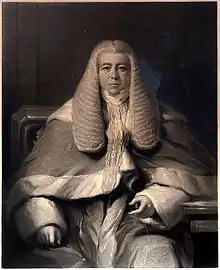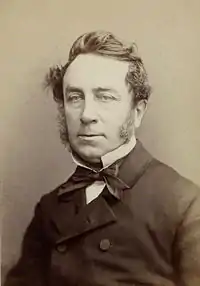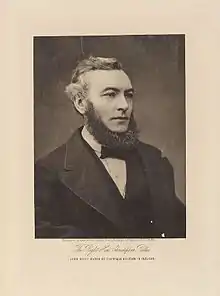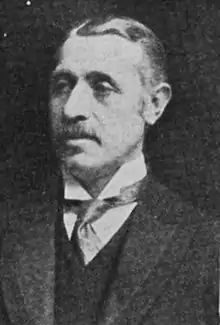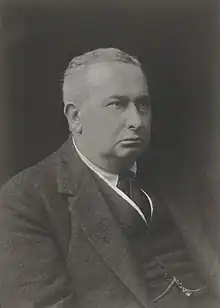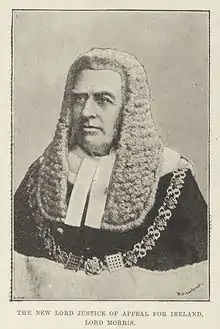

The Attorney-General for Ireland was an Irish and then (from the Act of Union 1800) United Kingdom government office-holder. He was senior in rank to the Solicitor-General for Ireland: both advised the Crown on Irish legal matters. With the establishment of the Irish Free State in 1922, the duties of the Attorney-General and Solicitor-General for Ireland were taken over by the Attorney General of Ireland. The office of Solicitor-General for Ireland was abolished at the same time for reasons of economy. This led to repeated complaints from the first Attorney General of Ireland, Hugh Kennedy, about the "immense volume of work" which he was now forced to deal with single-handedly.[1]
History of the Office
The first record of the office of Attorney General for Ireland, some 50 years after the equivalent office was established in England, is in 1313, when Richard Manning or Mannyn was appointed King's Attorney, or "King's Serjeant who follows the pleas" (the title Attorney General was not used until the 1530s),[2] at a salary of 5 marks a year. The Attorney General was initially junior to the serjeant-at-law, but since the titles King's Serjeant and King's Attorney were often used interchangeably, as in the case of Richard Manning, it can be difficult to establish who held which office at any given time.[2] Thomas Dowdall, for example, like Manning before him, was called Serjeant-at-law and King's Attorney in the 1460s at almost the same time.[3] Early holders of the office, including Manning, were permitted to take private clients.[2] Manning is on record as acting as attorney for Meiler Kendal in 1310, prior to his appointment as Attorney-General.[4] Casey states that the records cast very little light on the duties of the Attorney-General in the early years, possibly a reflection of his inferior status compared to the Serjeant-at-law.[2]
There are at least two references to a Deputy Attorney-General.[5] The first was in 1385, when Robert Hemynborough, or de Hemynborgh, was appointed Attorney-General "with power to appoint a Deputy".[6] Two centuries later, Edward Butler, who became Attorney-General in 1582, had acted as Deputy from 1578 to 1580.[5] Apart from these two examples, there is no evidence that the Deputy Attorney-General was a permanent position, nor do we know why it was considered necessary to appoint Butler to this office (pressure of work may be the explanation).
The early Attorneys-General might be licensed to appear in certain courts only. William Rouse (1342), Peter de Leycestre (1357), William Lynnoor (1359), Henry Mitchell (1372) and John Barry (1401) were all given a patent to plead in the Court of Common Pleas and the Court of Exchequer.[6] John White was described in 1426 as "King's Attorney in the King's Bench and the Exchequer".[7] Robert le Hore in 1379 was appointed King's Attorney to plead "before the justices of the Bench (this was not the Couurt of Bench but an early name for the Court of Common Pleas) and the Treasurer and chamberlains of the Exchequer".[8] In 1499 Clement Fitzleones, less typically, was appointed "King's Attorney in all Courts".[9] The Serjeant-at-law, by contrast, was generally licensed to appear in all the Royal Courts, although John Haire in 1392 was described as "Serjeant-at-law of our Lord the King in the Common Pleas".[3]
Perhaps because the Attorney-General was in the earlier centuries junior to the Serjeant-at-law, some holders of the office were probably not as highly qualified as the Serjeant. Thomas Archbold (or Galmole), appointed Attorney-General in 1478, was a goldsmith by profession, and, perhaps more suitably, was also Master of the Royal Mint in Ireland.
The Attorney-General and the Serjeant-at-law
In 1537 there was a short-lived attempt, following the report of a royal commission, to expand the role of the Attorney General, and abolish the office of King's Serjeant. The proposal was defeated largely through the firm opposition of the Serjeant-at-law, Patrick Barnewall, who argued that pleading cases on behalf of the Crown was and always had been the proper task of the Serjeant-at-law: "the King's Serjeant has always used to maintain the Pleas.... for this two hundred years and more". Why the more junior office was favoured over the much longer-established office of Serjeant is not clear.
From the early 1660s, due largely to the personal prestige of Sir William Domville (AG 1660–1686), the Attorney General became the chief legal adviser to the Crown. In certain periods, notably during the reign of Elizabeth I, who thought poorly of most of her Irish-born law officers, the English Crown adopted a policy of choosing only English lawyers for this office, and also the Solicitor-General.[2] Her successor King James I in 1620, on the appointment of Sir William Ryves, noted that the Attorney-General and Solicitor-General "have always been of the King's choice and special nomination",[6] and that they were the Crown servants in whom the King places, above his other learned counsel and officers of the Court: "his more special trust regarding the preservation of his revenue and possessions". It is interesting that the King here seems to place the Attorney and the Solicitor above the Serjeant-at-law in importance.[6]
Attorney-General in politics
The Attorney-General, in later centuries at least,[2] was always a member of the Privy Council of Ireland (in earlier centuries as a rule only the Serjeant-at-law attended the Council, but Stephen Roche, Attorney General 1441–44, attended the Great Council of 1441).[2]
A strong Attorney, like Philip Tisdall, William Saurin, or Francis Blackburne, could exercise great influence over the Dublin administration. Tisdall (AG 1760–1777), was for much of his tenure as Attorney General also the Government leader in the Irish House of Commons, and a crucial member of the administration. Saurin (AG 1807–1822) was regarded for many years as the effective head of the Dublin Government, until his career was ended by his opposition to Catholic Emancipation.[2] In 1841 Blackburne (AG 1830–1834, 1841–1842), on being challenged about a proposed appointment within his own office, said firmly that he "would not tolerate a refusal to ratify the appointment".[10]
The office of Attorney General was described as being "a great mixture of law and general political reasoning".[10]
Attorneys-General for Ireland, 1313–1922
14th century
- Richard Manning: appears as a barrister in private practice in 1310; appointed "King's Attorney" or King's Serjeant for Ireland 1313.[3] Still in office in 1327.[11]
- William de Woodworth: c. 1327[3]
- Thomas of Westham: 1334[2]
- William Rouse: 17 April 1342[12]
- William le Petit: 1343
- Nicholas Lumbard, or Lombard: 1345
- Robert de Emeldon: 1348
- Robert Preston, 1st Baron Gormanston: 1355
- John de Leycestre, or Lecestre: 1357[6]
- William Lynnoor: 12 February 1359[13]
- Henry Mitchell: 1372;[6] promoted to Chief Baron of the Irish Exchequer 1376
- Robert Hore, or le Hore: 1379,[Note 1] superseded 1381. He appears to have served a second term in 1383–84, as he was re-appointed on 21 October 1383[14] and the Close Rolls have an order to pay his arrears of salary for those two years.[15] On 28 July 1385 he was ordered not to "interefere" with the Office of Attorney-General any further.[16]
- Thomas Malalo: 15 January 1381[Note 1][17]
- Robert Hemynborgh or de Hemynborough: 18 July 1385[Note 1] (first term). He had the power to appoint a Deputy, one of the very few references in the records to such an office. His patent of office was renewed in 1407 on the same terms. He was to receive the same salary as Henry Mitchell had i.e. 1 pound and 1 shilling.
15th century
| Name | Term of office | Reason for leaving office | |
|---|---|---|---|
| William Tynbegh | 20 January 1400, having stepped down as a judge[Note 1][18] | ||
| John Barry | appointed 16 February 1401;[Note 1][19] | still in office in 1404 [20] | |
| Robert de Hemynborough | appointed for a second term in 1407, in the same manner as King Richard II had previously granted the office to him.[21] | ||
| John Whyte or White | appointed 20 August 1412[22] re-appointed 4 October 1413[23] re-appointed 19 October 1422;[Note 1][24] | still in office 1426, when he was described as "the King's Attorney in the Exchequer"[7] | |
| Stephen Roche | 1441 | ||
| William Sutton | 1444[25] | ||
| Robert FitzRery | 1450[26] | ||
| Thomas Dowdall | 1463[27] | ||
| Nicholas Sutton | 1471 or 1472[28][29] | ||
| Thomas Archbold | 1478 [30] | ||
| Thomas Cusacke | 1480[31] | ||
| Walter St. Lawrence | 1491[32][33] | ||
| Clement Fitzleones | 1499[34][35][36] | By 1505 | Appointed as King's Serjeant[36] |
16th century
incomplete - Smyth in his book Chronicle of the Irish Law Officers (London, 1839) noted that the destruction of many State records made it impossible to compile a full list of holders of the office. With the exception of one roll for the 6th year of Henry VIII (1514-5), the patent rolls for the reign of that monarch were extant from the 22nd year of his reign (1530-31), at the time of the Four Courts fire in 1922.[37][38]
| Name | Portrait | Term of office | Reason for leaving office | |
|---|---|---|---|---|
| John Barnewall, 3rd Baron Trimlestown | 1504 | 1504 | Appointed as Solicitor-General for Ireland and King's Serjeant | |
| Nicholas Fitzsimons | 1504 or later[39] | 1514 | Appointed third Baron of the Exchequer | |
| Unknown | ||||
| Thomas St. Lawrence | 18 August 1532[Note 1][40] | 12 August 1535 [Note 2][Note 1][41][42] |
Appointed as a Judge of the Court of King's Bench (Ireland) | |
| Robert Dillon | August 1535[Note 1] | 17 January 1554 [Note 2][Note 1][43][44] also [45][46] |
Appointed as a Judge of the Court of King's Bench (Ireland) | |
| Barnaby Skurloke or Skurlog | 1554[Note 1][47][48][49] re-appointed 26 January 1559[50][51] |
1559 | Dismissed | |
| James Barnewall | 3 September 1559[Note 1][52] | |||
| Lucas Dillon | 8 November 1566[Note 1][53] | 17 May 1570 [Note 2][Note 3][54] |
Appointed as Chief Baron of the Irish Exchequer | |
| Edward Fitz-Symon | 4 June 1570[Note 1][55] | 21 February 1574 [Note 2][Note 1][56] |
Appointed as King's Serjeant | |
| John Bathe | 21 February 1574[Note 1][57] | 1577 | Removed from office | |
| Thomas Snagge | 13 September 1577[Note 3][58] | 1580[59] | "returned to England in 1580, when he was appointed serjeant-at-law"[60] | |
| Christopher Flemyng, or Fleming | 9 September 1580[Note 1][61] | Death | ||
| Edmund or Edward Butler | 8 August 1582[Note 1][62] | 20 September 1583 [Note 2][Note 1][63] |
Appointed as a Judge of the Court of Queen's Bench (Ireland) | |
| Charles Calthorpe, afterwards Sir Charles | 22 June 1584[Note 1][64] | 19 April 1606 [Note 2][Note 3] |
Appointed as a Judge of the Court of Common Pleas (Ireland) | |
17th century
| Name | Portrait | Term of office | Reason for leaving office | |
|---|---|---|---|---|
| Sir John Davys or Davies MP for County Fermanagh (1613) |
 |
19 April 1606[Note 3] | 1619 | Resigned |
| Sir William Ryves | 30 October 1619[Note 1] | 7 August 1636 [Note 2][Note 3] |
Appointed as a Judge of the Court of King's Bench (Ireland) | |
| Richard Osbaldeston of Gray's Inn |
7 August 1636[Note 3] | June 1640 | Death | |
| Sir Thomas Tempest | 20 July 1640[Note 3] | |||
| William Basil | 18 July 1649[Note 1] | 24 January 1659[Note 2] | Appointed as Chief Justice of the Upper Bench for Ireland | |
| Robert Shapcote | March 1659 | May 1659 | Deprived of the position when the Rump Parliament was restored | |
| Unknown | May 1659 | February 1660 | ||
| Robert Shapcote | February 1660[Note 4] | May 1660 | Elected as MP for Tiverton in the Parliament of England in the Convention Parliament (1660), which assembled for the first time on 25 April 1660. | |
| Sir William Domville MP for County Dublin (1661-66) |
23 June 1660[Note 1] | Retired | ||
| Sir Richard Nagle MP for County Cork (1689) |
31 December 1686[Note 3] | 3 October 1691[Note 5][Note 6] | Jacobite Ireland ceased to exist due to the Treaty of Limerick | |
| Sir John Temple | 30 October 1690[Note 3][Note 7] | Retired | ||
| Robert Rochfort MP for County Westmeath |
 |
10 May 1695[Note 3] | 12 June 1707 [Note 2][Note 3] |
Appointed as Chief Baron of the Irish Exchequer |
18th century
19th century
20th century
The office was vacant from 16 November 1921[86] and succeeded by the Attorney General of the Irish Free State on 31 January 1922. The office of Attorney General for Northern Ireland had been created in June 1921.
Notes, references and sources
Footnotes
- 1 2 3 4 5 6 7 8 9 10 11 12 13 14 15 16 17 18 19 20 21 22 23 24 25 26 27 28 29 30 31 32 33 34 Date of patent
- 1 2 3 4 5 6 7 8 9 10 11 12 13 14 15 16 17 18 19 20 21 22 23 Date of appointment to office in next column
- 1 2 3 4 5 6 7 8 9 10 11 12 13 14 15 16 17 18 19 20 21 22 23 24 25 26 27 28 29 30 31 32 33 34 35 36 37 38 39 40 41 42 43 Date of Privy Seal
- ↑ Restored to the position when the secluded members of the Rump Parliament were allowed in in February 1660
- ↑ Date of the Treaty of Limerick
- ↑ Attorney-General for Jacobite Ireland only after the appointment of Sir John Temple as Attorney-General for Williamite Ireland on 30 October 1690
- ↑ Attorney-General for Williamite Ireland only until the Treaty of Limerick of 3 October 1691
- ↑ "[W]hen the Irish administration came under the domination of the ultra-tory lord chancellor, Sir Constantine Phipps, he was dropped as attorney general in 1711 and emerged as one of the principal leaders of the opposition."
- ↑ "In 1714 he was replaced as Irish attorney general in the whig purge which followed the accession of George I."
- ↑ "on the accession of George I in 1714 was superseded as attorney-general, but was offered the place of a justice of the King’s Bench, which he declined"
- ↑ "With the collapse of Lord North's government in March 1782, he was dismissed from office. Scott was generally believed to have known that he would be removed and to have decided to provoke his dismissal by asserting during the debates on legislative independence that Great Britain had no right to bind Ireland by acts of parliament"
- ↑ "Disappointed at not being named chief justice of the king's bench, he retired and was created a baronet on 21 June 1803. King George III ascribed his resignation to ill-health and his weaknesses as a law officer."
- ↑ "nor was he ever in the Irish or British House of Commons"
- ↑ "In October 1805 Pitt made Plunket attorney-general, and Plunket retained that office in the ‘ministry of all the talents’. Hitherto, with official approval, he had treated the post as professional and non-political. Now it became a party and parliamentary one. He ... was urged by Lord Grenville to enter the House of Commons. ... early in 1807. He ... became an adherent of Lord Grenville ... Having identified himself with the whigs, he declined the request of the new tory administration that he retain the attorney-generalship."
- ↑ "With all his present Toryism, he seems to have been then a Whig"
- ↑ "something of a republican by nature, but fashioned by circumstances into a Tory"
- ↑ he was one of the "Grenvillites who [in 1822] joined Liverpool's government"
- ↑ "was [after 1798] allied with the tory party"
- ↑ However, Chronicle of the Law Officers of Ireland does not mention him, and neither Elrington Ball's The Judges in Ireland, Volume 2, page 354 nor Pennefather's article in the Dictionary of National Biography mentions service in this office. "[T]he attorney-general-ship was ... offered to ... Edward Pennefather ... and on his declining to serve in a reform administration it was given on Pennefather's advice to ... Francis Blackburne".
- ↑ "was a conservative in politics"
- ↑ Cook, Chris; Keith, Brendan (1975). British Historical Facts, 1830-1900. London: Macmillan. p. 4. ISBN 978-1-349-01348-7.states that the office was vacant under Peel's Conservative government of 1834-35. However, Blackburne's article in the Dictionary of National Biography states that "He continued in that office until 1835, under Grey and during the initial short administrations of Melbourne and Peel." Also Blackburne, Edward (1874). Life of the Right Hon. Francis Blackburne: Late Lord Chancellor of Ireland. Macmillan and Co. p. 194. states that "Sir Robert Peel requested Blackburne to retain his office ... The Peel administration was destined to be of but short duration ... Melbourne was recalled to power ... Blackburne retired from office"
- ↑ "though known to be a tory ... with a view to the Irish administration having a broad political base"
- ↑ "was in politics a conservative"
- ↑ He had unsuccessfully sought re-election for the parliamentary constituency of Dungarvan in 1868.
- ↑ He unsuccessfully contested the parliamentary constituency of Londonderry City in 1872.
- ↑ He had unsuccessfully contested the parliamentary constituency of Carrickfergus in 1874.
- ↑ He had unsuccessfully contested the parliamentary constituency of Mallow in 1883.
- ↑ He had unsuccessfully contested the parliamentary constituency of North Londonderry in 1885.
- ↑ He had unsuccessfully contested the parliamentary constituency of West Derbyshire in 1892.
References
- Haydn's Book of Dignities (for pre-1691 names and dates)
- ↑ McCullagh, David (2010). The Reluctant Taoiseach: A Biography of John A Costello. Dublin: Gill & MacMillan. p. 48. Until 1929 the Attorney General had no full-time civil servants to assist him in giving legal advice, although there were a number of parliamentary draughtsmen.
- 1 2 3 4 5 6 7 8 9 Casey, James (1996). The Irish Law Officers. Round Hall, Sweet and Maxwell. p. 7.
- 1 2 3 4 Hart, A.R. The History of the King's Serjeants at law in Ireland. Four Courts Press, 2000. pp. 15, 20, 21.
- ↑ Patent Roll 4 Edward II
- 1 2 Ball 1926a, page 220.
- 1 2 3 4 5 6 Smyth Chronicle of the Law Officers of Ireland Henry Butterworth London 1839
- 1 2 Close Roll 5 Henry VI
- ↑ Close Roll 2 Richard II
- ↑ A Calendar of Irish Chancery Letters c.1244-1509
- 1 2 Delaney, V. T. H. (1960). Christopher Palles. Dublin: Allen Figgis and Co. p. 60.
- ↑ The National Archives Officers in Ireland anno primo R. Edward III, with their yearly fees
- ↑ A Calendar of Irish Chancery Letters c.1244-1509, published by Trinity College Dublin Entry 3 - 17 April 1342
- ↑ A Calendar of Irish Chancery Letters c.1244-1509, published by Trinity College Dublin Entry 1 - 12 February 1359
- ↑ A Calendar of Irish Chancery Letters c.1244-1509, published by Trinity College Dublin Entry 6 - 21 October 1383
- ↑ Close Roll 8 Richard II
- ↑ A Calendar of Irish Chancery Letters c.1244-1509, published by Trinity College Dublin Entry 40 - 28 July 1385 - Patent Roll 9 Richard II
- ↑ A Calendar of Irish Chancery Letters c.1244-1509, published by Trinity College Dublin Entry 77 - 15 January 1382
- ↑ A Calendar of Irish Chancery Letters c.1244-1509, published by Trinity College Dublin Entry 31 - 16 January 1400 (approximate date)
- ↑ A Calendar of Irish Chancery Letters c.1244-1509, published by Trinity College Dublin Entry 15 - 16 February 1400
- ↑ A Calendar of Irish Chancery Letters c.1244-1509, published by Trinity College Dublin Entry 123 - 20 January 1404
- ↑ Patent Roll 8 Henry IV
- ↑ A Calendar of Irish Chancery Letters c.1244-1509, published by Trinity College Dublin Entry 140 - 20 August 1412
- ↑ A Calendar of Irish Chancery Letters c.1244-1509, published by Trinity College Dublin Entry 23 - 4 October 1413
- ↑ A Calendar of Irish Chancery Letters c.1244-1509, published by Trinity College Dublin Entry 6 - 17 November 1426
- ↑ Ball 1926a, page 179.
- ↑ A Calendar of Irish Chancery Letters c.1244-1509, published by Trinity College Dublin Entry 47 - 10 October 1450
- ↑ Some sources refer to him as King's Serjeant, but the roles of Serjeant and Attorney at the time were easily confused.
- ↑ A Calendar of Irish Chancery Letters c.1244-1509, published by Trinity College Dublin Entry 6 - 22 May 1471
- ↑ Ball 1926a, page 183.
- ↑ Ball 1926a, page 185.
- ↑ Ball 1926a, page 187.
- ↑ Ball 1926a, page 110.
- ↑ Ball 1926a, page 190.
- ↑ A Calendar of Irish Chancery Letters c.1244-1509, published by Trinity College Dublin Entry 3 - 25 October 1499
- ↑ Entry 4 - 4 November 1499
- 1 2 Ball 1926a, page 188.
- ↑ Calendar of the patent and close rolls of Chancery in Ireland, page xxxviii
- ↑ page 2
- ↑ Ball 1926a, page 193.
- ↑ Letters Patent - 25 - 19 August, 24 and 25 Henry VIII
- ↑ Fiant - 44 - 12 August 1535
- ↑ Patent - 44 - no date in 1534-6
- ↑ Fiant - 22 - 17 January 1554
- ↑ Patent - 52 - 17 January 1554
- ↑ Fiant - 41 - 16 April 1554
- ↑ Patent - 53 - 16 April 1554
- ↑ Patent - 28 - 15 June 1556 (2 & 3 Philip & Mary) - Membrane 7
- ↑ Fiant - 233 - 1558 - no date
- ↑ Patent - page 373 - Art. 70 - no date in 1557/8 (4 & 5 Philip & Mary)- Membrane 9
- ↑ Fiant - 35 - 26 January 1559
- ↑ Patent - 169 - Membrane 15
- ↑ Patent - 178 - 3 September 1559 - John Barnewall
- ↑ Fiant - 946 - 8 November 1566
- ↑ Fiant - 1551 - 4 June 1570
- ↑ Fiant - 1552 - 4 June 1570
- ↑ Fiant - 2551 - 21 February 1574
- ↑ Fiant - 2552 - 21 February 1574
- ↑ - Letter of Appointment - 13 September, 20 Elizabeth (1578)
- ↑ Bedfordshire Library Website, Local Biographies - Thomas Snagge, retrieved 4 May 2023
- ↑ "Snagge, Thomas". Oxford Dictionary of National Biography (online ed.). Oxford University Press. doi:10.1093/ref:odnb/25971. (Subscription or UK public library membership required.)
- ↑ Fiant - 3662 - 9 September 1580
- ↑ Fiant - 4010 - 28 August 1582
- ↑ - Fiant - 4211 - 20 September 1583
- ↑ Fiant - 4458 - 22 June 1584
- ↑ Dictionary of Irish Biography
- ↑ Dictionary of Irish Biography
- ↑ Ball 1926, page 195.
- ↑ Dictionary of Irish Biography
- ↑ Dictionary of Irish Biography, citing History of Parliament
- ↑ Aspinall 1968, page 100, section 2748.
- ↑ Aspinall 1968, page 100, section 2746, note 2.
- ↑ William Courthope, ed. (1838). Debrett's complete peerage of the United Kingdom of Great Britain and Ireland (22nd ed.). p. 652. Archived from the original on 27 April 2016. Retrieved 11 December 2009.
- 1 2 "Plunket, William Conyngham, first Baron Plunket". Oxford Dictionary of National Biography (online ed.). Oxford University Press. doi:10.1093/ref:odnb/22415. (Subscription or UK public library membership required.)
- ↑ Sheil 1855, page 47.
- ↑ Sheil 1855, page 59.
- ↑ cited in Webb, Alfred (1878). A Compendium of Irish Biography. Dublin: M. H Gill & Son. p. 466.
- ↑ Ball 1926, page 347.
- ↑ Cook 1975, p. 4.
- ↑ Ball 1926, page 274.
- ↑ Ball 1926, page 354.
- ↑ Smith, G. B.; Hogan, Daire. "Blackburne, Francis (1782?–1867)". Oxford Dictionary of National Biography (online ed.). Oxford University Press. doi:10.1093/ref:odnb/2514. (Subscription or UK public library membership required.)
- ↑ Ball 1926, page 356.
- ↑ The transition from the Tory Party to the Conservative Party is considered to have occurred with the Tamworth Manifesto in December 1834
- ↑ "Brewster, Abraham". Oxford Dictionary of National Biography (online ed.). Oxford University Press. doi:10.1093/ref:odnb/3370. (Subscription or UK public library membership required.)
- ↑ "Atkinson, John, Baron Atkinson". Oxford Dictionary of National Biography (online ed.). Oxford University Press. doi:10.1093/ref:odnb/30495. (Subscription or UK public library membership required.)
- ↑ Butler, David; Butler, Gareth (1994). British Political Facts, 1900–1994. Macmillan. p. 9. ISBN 0-333-52617-1.
Further reading
- Aspinall, Arthur, ed. (1968). The later correspondence of George III. Vol. 4. Cambridge University Press.
{{cite book}}: CS1 maint: ref duplicates default (link) - Ball, F. Elrington (1926). The Judges in Ireland 1221–1921. Vol. I. London: John Murray.
- Ball, F. Elrington (1926). The Judges in Ireland 1221–1921. Vol. II. London: John Murray.
{{cite book}}: CS1 maint: ref duplicates default (link) - Cook, Chris; Keith, Brendan (1975). British Historical Facts, 1830–1900. London: Macmillan. ISBN 978-1-349-01348-7.
- Sheil, Richard Lalor (1855). Savage, M.W. (ed.). Sketches Legal And Political. Vol. I. London: Published for Henry Colburn by his successors, Hurst & Blackett.
{{cite book}}: CS1 maint: ref duplicates default (link) - Smyth, Constantine J. (1839). . London: Henry Butterworth.
{{cite book}}: CS1 maint: ref duplicates default (link)
External links
- Attorney-General for Ireland, list of office holders 1835–1921, with links to their Hansard contributions; from millbanksystems.com





_by_Hugh_Douglas_Hamilton.jpg.webp)


